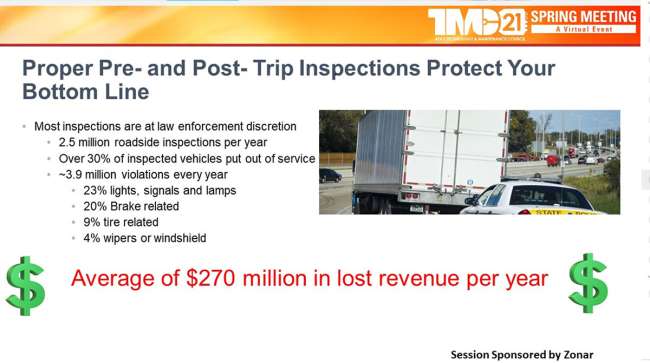Staff Reporter
TMC Highlights Importance of Electronic Inspection Reports

[Stay on top of transportation news: Get TTNews in your inbox.]
American Trucking Associations’ Technology & Maintenance Council highlighted the importance of using technology during truck inspections in an April 22 session of TMC’s virtual spring meeting.
Electronic driver vehicle inspection reports (eDVIRs) help digitize the inspection process to be more efficient and paperless.
“So as we know papers are inefficient and mistakes can easily be made,” said Fred Fakkema, vice president of safety and compliance for Zonar Systems. “When you do complete the paper, it just sits on a desk until its handled and time just keeps on ticking.”

Fakkema
EDVIRs can help streamline the inspection process to better detect and fix defects.
Fakkema noted that it still matters that the work is being put in during pre- and post-trip inspections. He also pointed out some of the most common roadside inspection violations can easily be prevented.
“So really the goal is to get the driver out of the cab and do that complete walk-around inspection of the vehicle,” Fakkema said. “It’s easy to stay in the seat and fill out a checklist on the electronic driver inspection report, but you want to leave the seat. So you want to have them walk those inspection zones.”
He added that sourcing, timing and inspections are critical because minor problems can turn into costly issues and repairs if not addressed. He also noted that eDVIRs have become even more important amid the need to decrease touch points because of COVID-19.
“The pandemic really helped prove that paper-based inspections are archaic,” Fakkema said. “Social distancing guidelines have impacted the way inspections are done. Digital tools for pre- and post-trip inspection, such as eDVIR, enable greater collaboration through the verification of activities. Electronic inspections also can help you during an audit. Having all that information right at your fingertips is important.”
The pandemic really helped prove that paper-based inspections are archaic.
Fred Fakkema, vice president of safety and compliance for Zonar Systems
Zonar Systems conducted a study of 1,100 vehicles that used its pre- and post-inspection service. The defect rate went high at the beginning because it was getting drivers to walk around the truck and do a full inspection. But once those defects were corrected, the vehicles became safer and more manageable as the defect rate declined.
“With telematics, you have a lot of tools out there that help make that data from the pre- and post-trip inspection even more effective,” Fakkema said. “It will help you with your predictive defects analysis and preventative maintenance as well. It will help you with those repair costs and keep them at a low level, especially when you catch it when it’s small.”
Fakkema noted roadside inspections often are at the discretion of law enforcement. But he also warned that many inspectors are drawn toward noticeable red flags such as unkempt and dirty trucks because that can indicate the vehicle is not being cared for.
“Talking about roadside inspections, we know that because of the pandemic they’ve really dropped,” Fakkema said. “So as things start to get back to that normalcy everybody keeps talking about, I don’t know how soon we’re going see it, but once we do get there, you’ll see those inspections go back up. That’s why it’s really important right now to do those pre-trip inspections.”

Even at Level 4 autonomy, self-driving trucks will have technical limitations. In this episode, we ask how technology developers are clearing those hurdles to make autonomous trucking a reality. We bring in Boris Sofman, head of engineering for the autonomous trucking program at Waymo. Hear a snippet above, and get the full program by going to RoadSigns.TTNews.com.
He added that there usually are about 2.5 million roadside inspections per year. More than 30% of them result in the vehicle being put out of service. Fakkema noted that about $270 million in revenue is lost annually due to roadside inspections based on the average cost per violation and the fine.
“With everything electronic today, there will be a newer version built upon mobile devices with aerial views of the vehicle and equipment,” Fakkema said. “The ability to attach photos to do those DVIRs and send that to maintenance staff to help get those corrected. You’ll have training tools such as videos and electronic guides that will be available. Not only for the maintenance side, but also the driver side.”
Want more news? Listen to today's daily briefing below or go here for more info:


